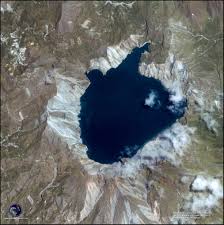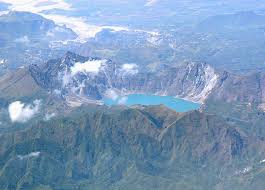MT. Pinatubo
 Mount Pinatubo is an active stratovolcano located on the island of Luzon, near the tripoint of the Philippine provinces ofZambales, Tarlac, and Pampanga. It is located in the Cabusilan Mountains separating the west coast of Luzon from the central plains. Before the volcanic activities of 1991, its eruptive history was unknown to most people. It was heavily eroded, inconspicuous and obscured from view. It was covered with dense forest which supported a population of several thousand indigenous people, the Aetas, who fled to the mountains during the Spanish conquest of the Philippines.
Mount Pinatubo is an active stratovolcano located on the island of Luzon, near the tripoint of the Philippine provinces ofZambales, Tarlac, and Pampanga. It is located in the Cabusilan Mountains separating the west coast of Luzon from the central plains. Before the volcanic activities of 1991, its eruptive history was unknown to most people. It was heavily eroded, inconspicuous and obscured from view. It was covered with dense forest which supported a population of several thousand indigenous people, the Aetas, who fled to the mountains during the Spanish conquest of the Philippines.
 The volcano's Plinian / Ultra-Plinian eruption on June 15, 1991 produced the second largest terrestrial eruption of the 20th century after the 1912 eruption of Novarupta in the Alaska Peninsula. Complicating the eruption was the arrival of Typhoon Yunya bringing a lethal mix of ash and rain. Successful predictions at the onset of the climactic eruption led to the evacuation of tens of thousands of people from the surrounding areas, saving many lives, but the surrounding areas were severely damaged by pyroclastic flows, ash deposits, and subsequently, by the lahars caused by rainwaters re-mobilizing earlier volcanic deposits causing extensive destruction to infrastructure and altering the river systems months to years after the eruption.
The volcano's Plinian / Ultra-Plinian eruption on June 15, 1991 produced the second largest terrestrial eruption of the 20th century after the 1912 eruption of Novarupta in the Alaska Peninsula. Complicating the eruption was the arrival of Typhoon Yunya bringing a lethal mix of ash and rain. Successful predictions at the onset of the climactic eruption led to the evacuation of tens of thousands of people from the surrounding areas, saving many lives, but the surrounding areas were severely damaged by pyroclastic flows, ash deposits, and subsequently, by the lahars caused by rainwaters re-mobilizing earlier volcanic deposits causing extensive destruction to infrastructure and altering the river systems months to years after the eruption.
The effects of the eruption were felt worldwide. It ejected roughly 10,000,000,000 tonnes (1.1×1010 short tons) or 10 km3(2.4 cu mi) of magma, and 20,000,000 tonnes (22,000,000 short tons) SO 2, bringing vast quantities of minerals and metals to the surface environment. It injected large amounts of aerosol into the stratosphere – more than any eruption since that ofKrakatoa in 1883. Over the following months, the aerosols formed a global layer of sulfuric acid haze. Global temperatures dropped by about 0.5 °C (0.9 °F), and ozone depletion temporarily increased substantially.
No comments:
Post a Comment